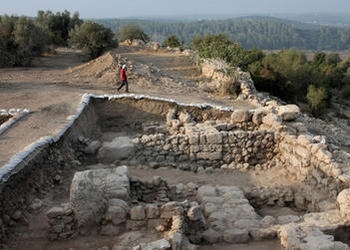God, Science and the Bible
An ancient fortress slowly yields its secrets

It sits on a ridge overlooking the Elah Valley along what was, in the time of the biblical kings Saul and David, the border between the Philistines and the kingdom of Judah. Archaeologists have been exploring it since 2007—and they're increasingly glad they have.
One unusual aspect of the site is that it shows only two short periods of occupation—one thin layer dating to the Hellenistic period (332-141 B.C.) and an extensive but short-lived Iron Age settlement dated to 1050-970 B.C.—the the time of King Saul and King David.
Such limited occupation with major construction is quite rare in an area where many cities were built, destroyed, and rebuilt again and again over thousands of years. As such, it is something of a "snapshot" of conditions at the time of Saul and David. What does this "snapshot" show, and why is it important?
The view many Bible critics long held was that Kings Saul, David and Solomon were mythical figures invented by Israelites to enhance their history. When the 1993 discovery of the Tel Dan stele with its inscription referring to the "house [dynasty] of David" proved David's existence, the argument then shifted to dismissing the biblical record of him as a king over Judah and Israel, with critics arguing that he was nothing more than a local tribal leader of no real significance, and that the kingdoms of Judah and Israel didn't exist as states until centuries later.
And this is where the findings at Khirbet Qeiyafa prove significant.
As noted earlier, Khirbet Qeiyafa is on the hotly contested border area between the Israelite kingdom and Philistia, the major rivals of Saul and David's day. The city was clearly constructed as a fortress—defended as it was by a massive wall 12 feet wide.
Site excavators Yosef Garfinkel of Jerusalem's Hebrew University and Saar Ganor of the Israel Antiquities Authority state that the "massive construction" of such defenses, including 10-ton blocks and an estimated 200,000 tons of stonework to build the walls, "proclaim the power and authority of a centralize[d] political organization, namely a state" ("Khirbet Qeiyafa: Sha'arayim," Journal of Hebrew Scriptures, Vol. 8, article 22).
In other words, the argument that an ancient Israelite state under a monarchy didn't come into existence until centuries later is rubbish—since the construction of such a fortress city would've required the backing and resources of a national power to make such an undertaking possible.
Says Professor Garfinkel: "This is the first time that archaeologists uncovered a fortified city in Judah from the time of King David . . . Thus, various suggestions that completely deny the biblical tradition regarding King David and argue that he was a mythological figure, or just a leader of a small tribe, are now shown to be wrong" (quoted by Rob Waugh, "Ancient Relics Are the First Definite Sign of the Bible's King David," The Daily Mail, May 9, 2012).
Garfinkel goes on to cite powerful evidence that the Elah Fortress is indeed Israelite rather that Philistine: "Over the years, thousands of animal bones were found, including sheep, goats and cattle, but no pigs. Now we uncovered three cultic [religious] rooms, with various cultic paraphernalia, but not even one human or animal figurine was found. This suggests that the population of Khirbet Qeiyafa observed two biblical bans—on pork and on graven images—and thus practiced a different cult [religion] than that of the Canaanites or the Philistines" (ibid.).
Another intriguing find is an ostracon, a pottery fragment bearing a written inscription. While scholars have yet to agree on the wording on the broken fragment, some feel it is the oldest Hebrew inscription yet discovered.
Can this site be identified with a biblical location? A clue to its identity was the discovery of a second city gate. This is the only site in the territory of the kingdoms of Judah and Israel yet discovered to have two gates. This unique feature led Garfinkel and Ganor to propose that this is the biblical city of Shaaraim (Joshua 15:36; 1 Samuel 17:52; 1 Chronicles 4:31-32), a name that in Hebrew means "two gates."
So in brief we have the existence of an Israelite fortress town, located in an area the Bible describes as being hotly contested by the Israelites and Philistines, constructed by what had to have been a significant national power, dating right to the time of Saul and David—all right in line with the scriptural record.
